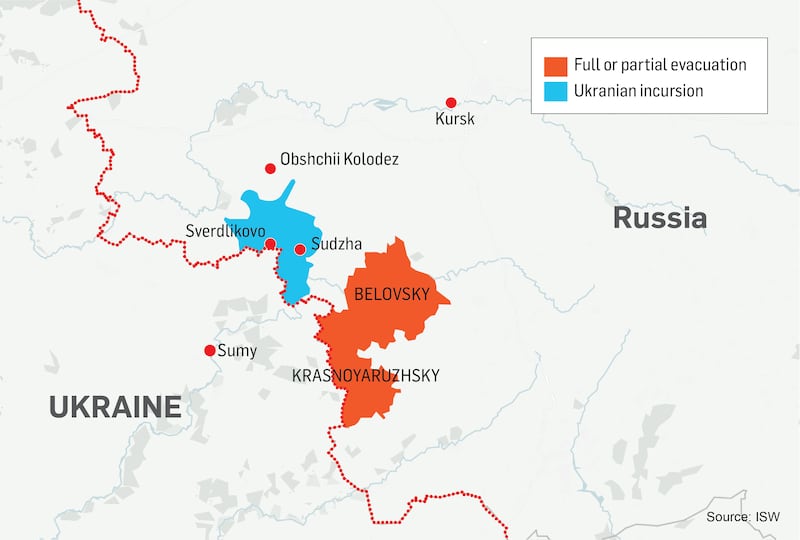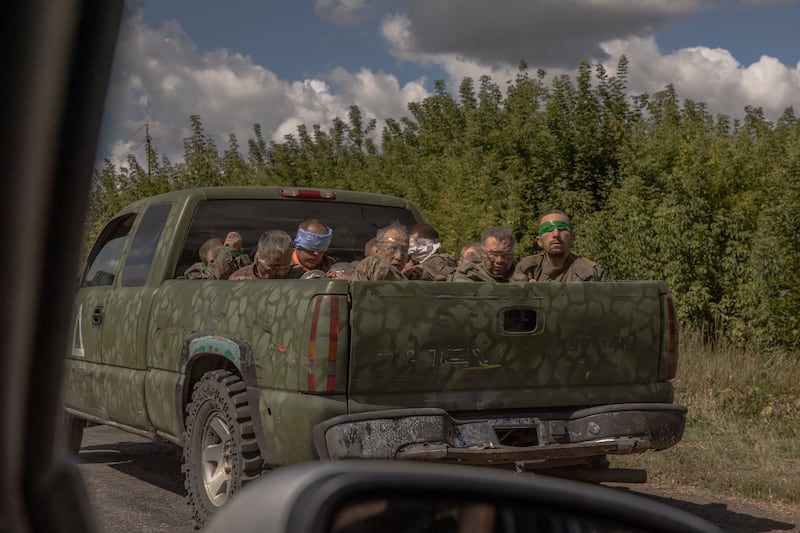As Volodymyr prepared to enter Russian territory, adrenaline ran through his veins. It was not lost on him that 81 years ago, another battle in Russia’s Kursk region marked a turning point for Europe.
He and the other soldiers of the 82nd air assault brigade listened to their commander’s instructions: eyes open, move swiftly and keep your country in your thoughts. Then, after a short prayer and a battle cry of “Glory to Ukraine!” they set out to invade Russia – the first foreign army to do so since the second World War.
“We entered Russian territory for the first time at 1pm on Tuesday [August 6th],” Volodymyr said. “We were among the first to enter there.”
To his astonishment, his unit faced no resistance as their eight-wheeled, 20 tonne US Stryker fighting vehicle stormed across the border in broad daylight.
They soon encountered a Russian unit “sitting in the forest, drinking coffee at a table”, Volodymyr recalled. “Then our Stryker drives right into their table.
“We killed many of them on the first day,” he said. “Because they were unarmed and didn’t expect us.”
Not wanting to end up like their comrades, he added, “dozens” of stunned Russian soldiers simply laid down their weapons and surrendered.

Over the next six days, the fear felt by many of the thousands of Ukrainian troops taking part in this audacious operation yielded to exhilaration. They advanced quickly – by 5km-10km a day – seizing several villages, part of a railway line and a key gas transit point. They began hastily digging positions and preparing for Russian reinforcements to arrive.
But to their surprise, Russian troops did not appear, at least not in the manner that they expected. Powerful glide bombs were launched from Russian jets, which wiped out some Ukrainian troops and valuable western-provided equipment. Lancet X-winged suicide drones came barrelling towards them. But the Ukrainians pressed on.
[ Ukraine’s incursion displaces more than 133,000 in RussiaOpens in new window ]
“It was a bit difficult at first but then it got easier,” said Roman, another soldier in Volodymyr’s unit.
On Friday, however, their Stryker was hit by a Russian rocket-propelled grenade. The driver suffered a concussion but everyone survived, thanks to the vehicle’s thick layer of armour. Unable to drive it further, they towed it back across the border.
When the Financial Times met the crew on Sunday, just 5km inside Ukraine, Volodymyr, Roman and two other soldiers were taking the damaged vehicle apart to see what could be used as spare parts for other Strykers before sending it to a US base in Germany for repairs.
As with the Russians, the US and German governments – two of Ukraine’s largest military and financial supporters – said they had not been informed in advance about the Ukrainian incursion.
Wolfgang Büchner, a German government spokesman, on Monday said the operation had been “prepared with great secrecy and without consultation” from Berlin. “Everything points to a spatially restricted deployment,” he added.
More than a dozen soldiers spoke about the operation on condition that their surnames not be published for security reasons.
“Our mood is good. Morale is high,” said Serhiy, a paratrooper from the 80th air assault brigade, sipping an energy drink on a road leading to Kursk.
As he spoke, explosions reverberated from the front line and a Ukrainian fighter jet flew at low altitude on its way back from an attack on Russian positions.
The Ukrainian troops said their operation was progressing as they had hoped. In less than a week, they had entered more than 30km inside Russia and claimed to have seized about 1,000sq km of territory. Volodymyr said they were still moving towards the regional capital, Kursk.
Russia had failed to halt their advance, the soldiers said. Many of its reinforcements have been captured or killed. One Russian convoy went up in flames after being struck with a US-made Himars missile, according to Ukrainian drone footage.

President Vladimir Putin has called the operation a large-scale “provocation” and Moscow has evacuated more than 130,000 residents from the Kursk and Belgorod regions bordering Ukraine.
Ukraine’s president Volodymyr Zelenskiy said at the weekend that Kyiv wanted to “push the war on to the aggressor’s territory” and put “pressure” on Russia to “restore justice”.
Few details are known about how the operation came together, and soldiers were careful to not reveal sensitive information. Many of the troops did not even know what the mission was until a few days in advance.
Elements of at least six Ukrainian brigades are involved, according to the soldiers and a review of combat footage published by the Ukrainian brigades on social media.
Volodymyr and the paratroopers of the 82nd brigade were brought to Ukraine’s northern Sumy region days before the operation began.
Other soldiers said – and their social media videos showed – that they had previously fought in flashpoints in the eastern Kharkiv region, where they were holding back Russian forces that had launched their own cross-border incursion there in May.

They had also been in Donetsk region, where the strategic towns of Chasiv Yar, Niu-York and Toretsk have been under relentless Russian attack for months.
Denys, a soldier driving a US-provided Humvee painted in desert camouflage, said the Kursk fight – in the same location as a major 1943 battle between German and Soviet forces – felt “totally different” from that in the Donetsk region.
“Fighting from defensive positions is much harder,” he said. “The enemy knows everything about us there. It knows where we are. Its drones can see our every move.
“Here we had the element of surprise,” he added. “But we were also surprised that [they were] so surprised with [our attack].”
Denys said the main goal of the operation was to capture Russian land. “We can fight here and take their territory. And then negotiations can start, and we will have some land of theirs to trade for our land,” he said.
Other soldiers said the objectives also included forcing Russia to divert resources from the Ukrainian front line. It is too early to tell whether they have been successful, with reports indicating only small numbers of troops have been pulled away from the Kharkiv and Donetsk fronts.
Putin on Monday claimed Russia’s forces continued to advance along the front line and said their “tempo of attack” had increased 50 per cent since the start of the Ukrainian incursion.
Some soldiers admitted to initially questioning the operation. A few said they were worried about leaving positions in Donetsk when the Russians were still making daily advances and threatening Kyiv’s hold on its last remaining cities there.
Denys worried the operation could come at the cost of cities in the Donetsk region. “Niu-York will be captured, 100 per cent,” he said. “It could even happen tomorrow.”
Russian forces were also likely to take Chasiv Yar and Toretsk, he predicted.
Before the Kursk operation, a senior Ukrainian official warned that “cracks” were forming in the defensive lines in the east.
Deep State, a Ukrainian analytical group with ties to the defence ministry that tracks and maps the front line, showed Russian forces making further gains around those eastern Ukrainian strongholds.
“These cities are already lost. They are only ours on the map. The Russians have wiped them out,” Denys said.
Even so, Ukrainian officials and military analysts worry their capture could hinder their military logistics and lead to Russia threatening remaining strongholds in the Donetsk region.
As in any daring military operation, the Ukrainians have taken casualties. Russia’s defence ministry claims to have killed more than 1,610 Ukrainian troops, numbers that are impossible to verify and which soldiers on the ground say are exaggerated. But many ambulances and armoured medical evacuation vehicles could be seen rushing to and from the front line.
Zoriana Stelmakh said that her brother, Denys Boyarchuk, a senior Ukrainian soldier in the 80th airborne assault brigade, had been killed in the operation’s early days. In a post on Instagram that featured videos and photos of Boyarchuk in uniform, Stelmakh said he “died fulfilling his oath to serve the Ukrainian people to the very end”.
Boyarchuk, who was known by his military call sign “Barista” because he had previously worked in a coffee shop, first joined the military in 2014, after the Kremlin annexed Ukraine’s Crimean peninsula and covertly invaded the eastern Donbas region with the aid of local separatist proxies.
Boyarchuk was fighting with the 80th brigade in Donetsk region when he was redeployed to Sumy region to take part in the incursion.
On Sunday, Boyarchuk was buried in a cemetery in western Ukraine.
The last time Stelmakh spoke with her brother was on August 4th, two days before Ukrainian troops entered Kursk. They argued “a little” like siblings sometimes do, she said.
Her last words to Boyarchuk were “I love you and hug you”. – Copyright The Financial Times Limited 2024
- Sign up for push alerts and have the best news, analysis and comment delivered directly to your phone
- Find The Irish Times on WhatsApp and stay up to date
- Our In The News podcast is now published daily – Find the latest episode here




















